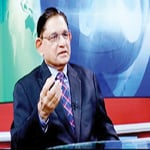INSIGHT
The failure in managing the declining key macroeconomic indicators is resulting in low growth and the issue may turn serious in 2020-21 as the country continues to suffer from security, corruption and governance related problems. The issue is believed to be compounding in the absence of civil military harmony on unmet important national and international challenges.
 The major hit will come from foreign exchange reserves in March 2018 that is likely to force the new government to once again knock the door of the IMF, which has been cautioning the government to adopt pro-growth and pro-export policies to largely benefit from China-Pakistan Economic Corridor (CPEC) project. An eight month long controversy over Panama scandal has further pushed the economy on the back seat, as the rulers are increasingly busy fixing their political opponents to win the next election instead of ensuring economic stability.
The major hit will come from foreign exchange reserves in March 2018 that is likely to force the new government to once again knock the door of the IMF, which has been cautioning the government to adopt pro-growth and pro-export policies to largely benefit from China-Pakistan Economic Corridor (CPEC) project. An eight month long controversy over Panama scandal has further pushed the economy on the back seat, as the rulers are increasingly busy fixing their political opponents to win the next election instead of ensuring economic stability.
According to the World Bank, Pakistan’s GDP growth rate is lagging behind India, Bangladesh, Nepal, and Bhutan that warrants serious efforts to deal with the issue. In its recent report, WB notes that sustainable and inclusive growth and poverty reduction requires greater private investment in the medium term and the government will have to focus on fiscal consolidation and structural reforms to have certain real economic turnaround in the country.
Key macroeconomic indicators including fiscal and current account deficit (twin deficits), growth, revenues, exports, foreign direct investment (FDI), agriculture, manufacturing, savings and private investment all are falling behind the target, notwithstanding the official claim of strong economic recovery being seen after many years.
The country’s three top economists have expressed their serious concern over the current state of the economy and said Pakistan would have to confront problems on both the internal and economic fronts in 2020-21. They regretted that the government seemed unmoved to address acute problems and challenges in a timely manner.
“I am really worried about the next two years, what to talk of 2020-21 when things will be out of our hands as the rulers are no interested in fixing the struggling economy,” said former finance minister Dr Salman Shah.
“There was no real input of the government, therefore, there was no real output to fix the economy which is falling behind all the seven regional economies. Without increasing productivity and competiveness, local and foreign debt will continue to accumulate and all other economic indicators will not show any improvement,” Dr Shah warned.
Dr Ashfaque Hasan Khan was of the view that the speed with which the government was borrowing and carelessly dealing with other economic issues, things were bound to turn horrifying much before 2020-21. “I see serious troubles in 2019-20 when we will be rushing towards IMF for rescue,” he said, and added that growing political instability was causing economic instability and rulers were dragging the nation into a debt trap. “I am very disappointed with the way economic issues are being tackled by Dar led economic team of the PML-N government.”
Another prominent economist Dr Shahid Hasan Siddique pointed out that 2020-21 will be a very crucial year for Pakistan when the investors of the CPEC start taking out their profit from the energy sector projects that offer a very high rate of return. “Then the real crisis will begin its incredible pressure on our foreign exchange reserves,” he said, regretting that investment profit on CPEC related energy projects was 20 percent compared to four percent interest rate on loans.
The matter would start worsening when the government would seek external borrowing for the proposed industrial zones to be set up at sites near CPEC projects. “By that time our external debt will assume alarming proportions and who knows what conditions the foreign lender will put to compromise our national goals to offer any assistance,” Dr Siddique said.
Ironically, the government continues to defend its economic policies and is unprepared to agree with the independent economists. At times, even the central bank reports concede that all is not well on the economic front and desperate measures are required to arrest the declining trends in the economy.
The issue of current account deficit, which has widened and almost doubled, needs to be dealt with by the government’s planners sitting in the ministry of finance and the State Bank of Pakistan. The country’s current account balance has recorded a deficit of $2.601 billion during July–Nov 2016 as compared to $1.362 billion during the same period last year, depicting an increase of $1.26 billion or 90.69 percent. The overall deficit was primarily driven by the widening gap in the merchandise account and slower foreign inflows.
War on terror has caused $118.3 billion from 2002 to 2016, but Pakistan was compensated only by $14 billion through coalition support fund (CSF). Most of the foreign exchange reserves were built by seeking external loans instead of increasing exports and home remittances. Exports are perpetually on a declining mode and went down from $24.5 billion in 2012-13 to $17.9 billion in 2014, while trade deficit is increasing and standing at 5.9 percent of the GDP. Cost of doing business in Pakistan is also not globally competitive, while home remittances are declining and standing at five percent of GDP in 2015-16 as compared to 6.9 percent of 2014-16. Tax-to-GDP ratio is still one of the lowest standing at less than 10 percent.
According to the central bank, total public debt and liabilities have risen to Rs22,461.9 billion (over Rs22 trillion) which is 75.9 percent of the GDP if calculated at $280 billion, the size of Pakistan’s economy. The situation is said to be rapidly worsening, and if rulers continue to extensively borrow from both local and external sources, the total debt and external liabilities would reach 100 percent of the GDP in the next few years. Pakistan’s high level of public debt is largely financed through short term instrument and does not auger well to improve the overall economy.
Those who have been dealing with the issue maintain that growing debt level is getting unsustainable and there is nothing to fall back on to avoid a debt trap. Sindh education minister Jam Mehtab Hussain Dahar is predicting that Pakistani economy is going to collapse like Greece in the next ten years. Nobody at the federal or provincial level has contradicted the provincial minister, which is being taken as fait accompli in official and unofficial quarters.
There is a consensus in the country that the economy needs to be strengthened through structural reforms in the taxation system, without which there cannot be any new resource mobilisation. It is desperately needed to remove the over Rs1.5 trillion gap between income and expenditure.
Indirect taxation has gone as high as 70 percent, adding miseries atop the poorer sections of the society. Taxation system has been destroyed by regularly enlarging the withholding tax regime and by extending amnesty schemes to help whiten black money owned by businessmen and investors. Interestingly, amnesty schemes are always offered to the holders of invisible assets. But this time around this was also given to the real estate sector that has visible assets.
Unfortunately, no real effort has been made by the successive governments to tackle the challenges like poverty, illiteracy, corruption, and inequalities. Energy and governance related issues are bringing negative effects on growth and development.

Dr Shahid Hasan Siddique, senior economist
“2020-21 will be a very crucial year for Pakistan when the investors of the CPEC start taking out their profit from the energy sector projects that offer a very high rate of return. Then the real crisis will begin its incredible pressure on our foreign exchange reserves. The investment profit on CPEC related energy projects is 20 percent compared to four percent interest rate on loans.”

Dr Salman Shah, former finance minister
“I am really worried about the next two years, what to talk of 2020-21 when things will be out of our hands as the rulers are no interested in fixing the struggling economy. There was no real input of the government, therefore, there was no real output to fix the economy which is falling behind all the seven regional economies. Without increasing productivity and competiveness, local and foreign debt will continue to accumulate and all other economic indicators will not show any improvement.”

Dr Ashfaque Hasan Khan, dean NUST
The speed with which the government is borrowing and carelessly dealing with other economic issues, things are bound to turn horrifying much before 2020-21. I see serious troubles in 2019-20 when we will be rushing towards IMF for rescue. The growing political instability is causing economic instability and rulers are dragging the nation into a debt trap. I am very disappointed with the way economic issues are being tackled by Dar led economic team of the PML-N government.”
India which was behind Pakistan in terms of GDP and overall development for well over 40 years, is on a driving seat as its economic activity is expected to accelerate to 7.7 percent in 2017 after maintaining a solid 7.6 percent growth in consumption. On the other hand Pakistani economic activity is projected to accelerate over the medium term reaching 5 percent in 2017 and 5.4 percent in 2018.
There has been some improvement in the backdrop of CPEC infrastructure projects and the related public investment. The World Bank notes that sustainable and inclusive growth and poverty reduction will require greater private investment which is not forthcoming due to one reason or the other.
Another strong view is that there is collusion between the provinces and the federal government to show surpluses so as to have less fiscal deficit which is the negation of the 18th amendment and 7th national finance commission award agreed in 2009. With the result there is no increased spending on education and health in the provinces.
There has been a failure in generating adequate taxes and curtailing and minimising public sector losses. Free market based economies require framework that allocate resources efficiently and result in capital formation and inclusive growth.
Going forward only relying on CPEC by calling it a game changer may not help in the long run as the government will have to adopt policies that attract foreign investment; an important tool to have better GDP growth rate. Also certain level of financial discipline has to be adopted to ensure transparency and improved governance at all levels. The much awaited structural reforms in the energy and tax sectors are also must to achieve any real economic turnaround. Effective regulatory reforms are required to unearth undocumented economy, which has surpassed the formal economy in size. Also, planners need to come clean and avoid manipulated economic numbers to show higher growth rate.
The writer is a senior journalist based in Islamabad